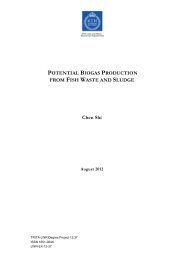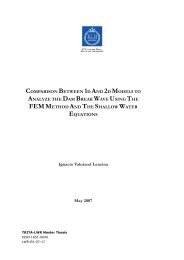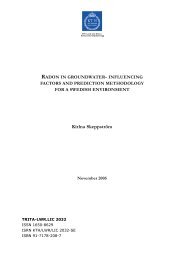Water <strong>sources</strong>, <strong>infrastructure</strong>, <strong>space</strong> <strong>and</strong> <strong>the</strong> <strong>dynamics</strong> <strong>of</strong> environmental diseases in Saboba District: Using GISIndia, Iran <strong>and</strong> Pakistan. The politicisations <strong>of</strong> <strong>water</strong> issues <strong>and</strong> violentprotest (e.g. Ghana since 2001) may also occur in reaction to <strong>water</strong>privatisation.On a similar vein like Postel <strong>and</strong> Wolf (2001), CSIS-SNL (2005) notedthat <strong>water</strong> is <strong>the</strong> basic foundation <strong>of</strong> life; <strong>and</strong> human prosperity,economic development <strong>and</strong> political stability will be retarded in thoseregions where <strong>the</strong> quality <strong>and</strong> reliability <strong>of</strong> <strong>water</strong> supplies remainuncertain. With no access to a reliable <strong>and</strong> appropriate source <strong>of</strong> <strong>water</strong>,families, usually women (<strong>and</strong> girls) spend a lot <strong>of</strong> <strong>the</strong>ir time fetching<strong>water</strong>. Water-related diseases <strong>and</strong> <strong>the</strong> time spent in fetching <strong>water</strong>, keepchildren from attending school <strong>and</strong> retard <strong>the</strong> adults’ productivity. Theopportunity forgone in terms <strong>of</strong> productivity can reach hundreds <strong>of</strong>million <strong>of</strong> dollars, even in poorer regions.According to WHO <strong>and</strong> UNICEF (2004) more than one billion peopleon Earth (near one-sixth <strong>of</strong> <strong>the</strong> world’s population) currently rely on<strong>water</strong> <strong>sources</strong> that are unsafe, unreliable, or difficult to access for <strong>the</strong>irdaily domestic uses. The organisation also estimated that about one-third<strong>of</strong> <strong>the</strong> world’s population lack access to basic <strong>water</strong> <strong>and</strong> sanitationfacilities. As a result, millions <strong>of</strong> people, most <strong>of</strong> <strong>the</strong>m children, women<strong>and</strong> <strong>the</strong> aged are suffering <strong>and</strong> dying annually from diseases related topoor <strong>water</strong> quality. Vörösmarty et al (2000) believe <strong>the</strong> magnitude <strong>of</strong> thischallenge can double in <strong>the</strong> next two decades. To <strong>the</strong>m, aside <strong>the</strong>reduction in productivity caused by inadequate access to safe drinking<strong>water</strong> <strong>and</strong> improved sanitation is what is dubbed <strong>the</strong> silent killer <strong>of</strong> <strong>the</strong>developing world.Also Gleick (2002a) is <strong>of</strong> <strong>the</strong> view that by <strong>the</strong> year 2025, more peoplecould die <strong>of</strong> <strong>water</strong>-related diseases than will perish from <strong>the</strong> HIV/AIDSp<strong>and</strong>emic. These trends will have great consequences for prosperity <strong>and</strong>stability, unless <strong>the</strong> trend <strong>of</strong> this problem is drastically reduced (Gleick,2002b). He believes that today than later, should be <strong>the</strong> starting line.Difficulties in managing <strong>water</strong> re<strong>sources</strong>Botterweg <strong>and</strong> Rodda (1999) have pointed out that <strong>water</strong> management isa complex process since it involves many actors at different levels,especially when it crosses national boundary. In this latter case, <strong>the</strong>yargued that national authorities are dependent on <strong>the</strong> compliance <strong>of</strong>actors <strong>the</strong>y cannot force by traditional government measures. To <strong>the</strong>m,<strong>the</strong> success <strong>of</strong> management initiatives is dependant on among o<strong>the</strong>rthings persuasion, incentives, <strong>and</strong> <strong>the</strong> flow <strong>of</strong> information between <strong>the</strong>seactors. The writers concluded that due to <strong>the</strong> fact that <strong>the</strong>re are manyactors involved <strong>and</strong> none can force <strong>the</strong> o<strong>the</strong>r actors to comply make<strong>water</strong> management issues more complex.Huisman et al (2000) work compliments Botterweg <strong>and</strong> Rodda (1999)above. They added that most cross-border commissions cannot force <strong>the</strong>member states to adopt laws, or firms to use <strong>the</strong> best availabletechnology. Hence, <strong>the</strong>ir role is <strong>of</strong>ten simply to advise <strong>the</strong> governments.It is for this reason that <strong>the</strong> judicial (drafting <strong>of</strong> agreements <strong>and</strong>adjudication) <strong>and</strong> <strong>the</strong> police service (law enforcement) will beinstrumental in <strong>water</strong> re<strong>sources</strong> management.Ehin (2003) states that people behaviours toward <strong>water</strong> management aredriven by knowledge, expertise <strong>and</strong> <strong>the</strong> role <strong>of</strong> culture, norms, values <strong>and</strong>habits. Thus, experts from <strong>the</strong> different disciplines <strong>and</strong> societal normshave different viewpoints that are difficult to integrate. For example, <strong>the</strong>pollution control person wants to talk about putting an end to pollution. Theeconomist is interested in comparing treatment costs versus source5
Mat<strong>the</strong>w Biniyam KursahTRITA LWR Master Thesisprotection, while <strong>the</strong> planner wants to talk about site. Ehin fur<strong>the</strong>rargued that ecologists are interesting in preserving <strong>the</strong> integrity <strong>of</strong>ecological subsystems, while sociologists emphasise that <strong>the</strong> mostimportant actors are human beings, whose patterns <strong>of</strong> socialestablishment are crucial for planning viable solutions to achievingsustainability <strong>of</strong> <strong>water</strong>. Also, <strong>the</strong> public health expert is interested indiscussions about parasites <strong>and</strong> all impurities contained in <strong>water</strong>. Thedifferent views are <strong>of</strong>ten treated incoherently. While <strong>the</strong>re is no doubtthat any <strong>of</strong> <strong>the</strong> viewpoints is important as <strong>the</strong> o<strong>the</strong>r, <strong>the</strong>ir continuetreatment as separate views hinder effective <strong>water</strong> management practices.Attempts should <strong>the</strong>refore be made to integrate <strong>the</strong> various views.However, Elin (2003) noted that <strong>the</strong> problem is that it is difficult for oneperson with one <strong>of</strong> <strong>the</strong> view points to underst<strong>and</strong> o<strong>the</strong>rs’ views due to<strong>the</strong> dilemma <strong>of</strong> dealing with different mindframes.Strategies for efficient <strong>water</strong> re<strong>sources</strong> managementSmith (1981) “built” upon Garrett Hardin’s (1968) Tragedy <strong>of</strong> <strong>the</strong> Common<strong>the</strong>ory reviewed earlier. Smith believes that <strong>the</strong> problem <strong>of</strong>overexploitation is <strong>the</strong> results <strong>of</strong> re<strong>sources</strong> being under public ra<strong>the</strong>rthan private ownership. By its very nature, a property resource owned by<strong>the</strong> commons is in effects owned by everyone <strong>and</strong> owned by no one (ibid). As aresult, no one has an incentive to maintain/preserve it, leading tooveruse or waste <strong>of</strong> <strong>the</strong> common resource in question. The writer<strong>the</strong>refore came to <strong>the</strong> conclusion that private ownership results insustained-yield use <strong>and</strong> preservation. In principle, Smith thus advocatesfor privatisation <strong>of</strong> <strong>water</strong> as <strong>the</strong> best managing strategy. However, he hasalso failed to show how <strong>water</strong> <strong>sources</strong> can become a private property –managed <strong>and</strong> protected by whom?CSIS-SNL (2005) believes that increasing local participation in <strong>the</strong>planning, implementation, <strong>and</strong> maintenance <strong>of</strong> <strong>water</strong> projects wouldimprove sustainability by preventing oversight, incorporate localknowledge <strong>and</strong> needs, <strong>and</strong> make it acceptable in <strong>the</strong> “eyes” <strong>of</strong> <strong>the</strong>community. The institute also argued that incorporating publicparticipation will help combine health, social <strong>and</strong> economies aspects <strong>of</strong><strong>the</strong> people. For this to be effective, <strong>the</strong>re must be efficient decentralisedadministration. However, low levels <strong>of</strong> public education, such as <strong>the</strong> casein Saboba district, sharp societal divides <strong>and</strong> possible corruption act toobstruct civil society in making rational <strong>and</strong> unbiased decisions. Myopinion is that <strong>the</strong> solutions/strategies being adopted to manage <strong>water</strong>re<strong>sources</strong> must first gain policy priority <strong>and</strong> be specific to <strong>the</strong>socioeconomic, political <strong>and</strong> geographic conditions <strong>of</strong> <strong>the</strong> regionconcerned.Ghana situations <strong>of</strong> <strong>water</strong> supply <strong>and</strong> managementNsiah-Gyabaah (2001) in his research titled “The looming nationaldilemma <strong>of</strong> <strong>water</strong> crisis in peri-urban areas in Ghana” pointed out thatmisuse <strong>of</strong> <strong>water</strong> <strong>and</strong> wastage through pipe burst, pollution throughagriculture, rapid population growth, urbanisation <strong>and</strong> domestic wastedisposal systems were among <strong>the</strong> causes <strong>of</strong> peri-urban <strong>water</strong> supplyproblems in <strong>the</strong> country. He noted that <strong>the</strong> increase in population <strong>and</strong>urbanisation, particularly <strong>the</strong> conversion <strong>of</strong> <strong>water</strong>sheds into residential<strong>and</strong> farml<strong>and</strong> areas has led to <strong>the</strong> depletion <strong>of</strong> <strong>water</strong> re<strong>sources</strong>, especiallyits quality. He concluded that Ghana needs an explicit <strong>water</strong> policy inorder to solve <strong>the</strong> recurrence <strong>of</strong> <strong>the</strong> inadequacy in <strong>water</strong> supply. On asimilar view but much fur<strong>the</strong>r, Arapto <strong>and</strong> Adisenu (2006) are <strong>of</strong> <strong>the</strong>view that ineffective community participation is as a result <strong>of</strong> <strong>the</strong> factthat <strong>the</strong> general public in Ghana hold <strong>the</strong> view that it is <strong>the</strong> responsibility6
- Page 1 and 2: Supervisor: Ulla MortbergCo-supervi
- Page 3 and 4: Water sources, infrastructure, spac
- Page 5 and 6: Water sources, infrastructure, spac
- Page 7 and 8: Water sources, infrastructure, spac
- Page 9 and 10: Water sources, infrastructure, spac
- Page 11 and 12: Water sources, infrastructure, spac
- Page 13 and 14: Water sources, infrastructure, spac
- Page 15 and 16: Water sources, infrastructure, spac
- Page 17 and 18: Matthew Biniyam KursahTRITA LWR Mas
- Page 19: Matthew Biniyam KursahTRITA LWR Mas
- Page 23 and 24: Matthew Biniyam KursahTRITA LWR Mas
- Page 25 and 26: OberadeYusungaManieBilyimbaMatthew
- Page 27 and 28: Matthew Biniyam KursahTRITA LWR Mas
- Page 29 and 30: Matthew Biniyam KursahTRITA LWR Mas
- Page 31 and 32: Matthew Biniyam KursahTRITA LWR Mas
- Page 33 and 34: Matthew Biniyam KursahTRITA LWR Mas
- Page 35 and 36: Matthew Biniyam KursahTRITA LWR Mas
- Page 37 and 38: Matthew Biniyam KursahTRITA LWR Mas
- Page 39 and 40: Matthew Biniyam KursahTRITA LWR Mas
- Page 41 and 42: PercentagePercentageMatthew Biniyam
- Page 43 and 44: Matthew Biniyam KursahTRITA LWR Mas
- Page 45 and 46: Matthew Biniyam KursahTRITA LWR Mas
- Page 47 and 48: Matthew Biniyam KursahTRITA LWR Mas
- Page 49 and 50: BilyimbaMatthew Biniyam Kursah Nadu
- Page 51 and 52: ManieBilyimbaBaguliMatthew Biniyam
- Page 53: ManieBilyimbaMatthew Biniyam Kursah
- Page 56 and 57: Matthew Biniyam KursahTRITA LWR Mas
- Page 58 and 59: Matthew Biniyam KursahTRITA LWR Mas
- Page 60 and 61: Matthew Biniyam KursahTRITA LWR Mas
- Page 62 and 63: Matthew Biniyam KursahTRITA LWR Mas
- Page 64 and 65: Matthew Biniyam KursahTRITA LWR Mas
- Page 66 and 67: PercentagesPercentagesMatthew Biniy
- Page 68 and 69: PercentagesMatthew Biniyam KursahTR
- Page 70 and 71:
Matthew Biniyam KursahTRITA LWR Mas
- Page 72 and 73:
Matthew Biniyam KursahTRITA LWR Mas
- Page 74 and 75:
Matthew Biniyam KursahTRITA LWR Mas
- Page 76 and 77:
Matthew Biniyam KursahTRITA LWR Mas
- Page 78 and 79:
Matthew Biniyam KursahTRITA LWR Mas
- Page 80 and 81:
Matthew Biniyam KursahTRITA LWR Mas
- Page 82 and 83:
Matthew Biniyam KursahTRITA LWR Mas
- Page 84 and 85:
Matthew Biniyam KursahTRITA LWR Mas
- Page 86 and 87:
Matthew Biniyam KursahTRITA LWR Mas
- Page 88 and 89:
Matthew Biniyam KursahTRITA LWR Mas
















